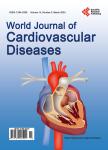Epidemio-Clinical, Therapeutic and Evolutive Aspects of Aortic Dissection in the Cardiology Department in Poin “G” Hospital University Center Bamako
Epidemio-Clinical, Therapeutic and Evolutive Aspects of Aortic Dissection in the Cardiology Department in Poin “G” Hospital University Center Bamako作者机构:Cardiology Department Point “G” Hospital University Center Bamako Mali Cardiology Department Hospital Kati Bamako Mali Cardiology Department Gabriel TOURE Hospital University Center Bamako Mali Higher Institute of Health Sciences Nazi Boni de Bobo Dioulasso University Bobo Dioulasso Burkina Faso Cardiology Department Hospital Mali Bamako Mali Medical Department of Institute for Studies and Research Bamako Mali
出 版 物:《World Journal of Cardiovascular Diseases》 (心血管病(英文))
年 卷 期:2018年第8卷第8期
页 面:424-430页
主 题:Aortic Dissection Cardiology Point G Hospital
摘 要:Objective: The work aimed at describing an epidemioclinical, therapeutic and evolutionary characteristics of patients hospitalized for aortic dissection in the cardiology department in Point “G Hospital University Center in Bamako—Mali. Methodology: It was a descriptive cross-sectional study from January 2010 to February 2017 in the CHU Point G cardiology department, including all patients hospitalized during this period. Results: Of 6912 hospitalized patients, 23 patients were concerned by aortic dissection. The prevalence of aortic dissection was 0.33%. The most affected age group was 50 - 69 (43.5%) of patients. The predominance was male with a sex ratio of 4.75. The cardiovascular risk factors were high blood pressure (73.9%) and smoking (60.9%). The major functional signs were chest pain (65.2%) and dyspnea (65.2%). Asphygmy (56.5%) and breath of aortic insufficiency (60.9%) were the dominant physical signs. The electrocardiogram recorded sinus tachycardia with 86.9% of patients. The radiographic of the frontal thorax showed mediastina widening (73.9%). At echocardiography, dilatation of the ascending aorta was described with 73.9% and the intimal veil (47.8%). Pericardial effusion was observed with 26.1% of patients. In the thoracic angioscan, the aortic dissection gave 43.5% for type A and 56.5% for type B. The aneurysm of the aorta was abdominal with 21.7%, ascending portion (13.0%) and descending with 8.7%. Complications were dominated by heart failure (47.8%) and aneurysm of the aorta (34.8%). The lethality was 52.2%. Conclusion: Aortic dissection is a medical and surgical emergency with poor prediction.



